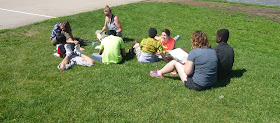 |
| Abstract paintings often have a Kafkaesque feel |
Franz Kafka was a 19th Century German writer with books about “surreal predicaments and incomprehensible bureaucratic powers” in which his characters descend into alienation in the face of absurdity.
Think of films like The Trial by Orson Wells, Mulholland Drive by David Lynch or the futuristic crime dystopia by Stanley Kubrick, A Clockwork Orange.
POLICE INNOVATION
Kafkaesque thoughts surfaced when I read the 2013 and 2015 programs of the Police Innovation Conferences. These conferences were not really about police innovation as you might expect. Rather they were technology conferences offering a tech version of police innovation with some very cool gizmos such as drones and robots, brain fingerprinting, and body cams.
The gizmos look cool and I’m sure they have useful applications.
However in today’s police environment there is a much bigger picture. If this were one single technology conference it would be a fun curiosity. But today policing is inundated with so many conferences of similar themes, they detour rather than direct us to a sustainable, post-Ferguson future. A small sample:
- A national conference on future police trends in which the future is technology
- A conference on Smart policing that navigates the future with data and intelligence analysis
- In Canada, economics of policing conferences with perpetual prattle about fiscal efficiencies and belt tightening, all the while ignoring the private sector and problem-oriented policing strategies that will achieve it.
CANDLES IN THE DARK
I have yet to see conferences about innovations in police training, such as basic academy courses that teach cops how to work with urban planners to build safer, CPTED-sensitive parking lots before carjackings and car thefts unfold.
Where are sessions on innovative methods to help get cops out of cars and into neighborhoods to work with social activists and faith groups to cut the roots of gang membership before the shooting starts.
There is little available about emotional intelligence skills that arm officers with better conflict resolution and situational awareness tactics to disarm offenders without killing them, or risking officers lives.
To be fair, there are a few candles in the dark - conferences focused on practical, grass-roots police work such as this year’s Problem-Oriented Policing conference in Portland. There are also a few small conferences such as this year’s Police Society for Problem-Based Learning in Madison or the International CPTED Association conference in Calgary. But these conferences do not command the policy discourse. What does? The Armadillo!
ENTER KAFKA
One session at these tech conferences was “Empowering the community - low tech crime prevention”. This session was about how police retrofitted an armored combat military vehicle called an Armadillo with video cams, audio surveillance, and so forth.
The goal? Deploy the Armadillo...
“to high crime areas or places that have experienced a spike in public nuisance type events. The Armadillo feels right at home when parked directly in front of a drug house or problem bar… a symbolic representation of restorative justice in places that have demonstrated public nuisance activity..”
“At home in front of a drug house or problem bar?” No doubt there is honest intention here, yet you just know Kafka is rising from the dead!
“A symbol of restorative justice?” Seldom was a more Kafkaesque phrase served up in the name of public safety.
In the spirit of a more common-sensical and balanced future, may we dispense with tactics that awaken dead German writers and get on with the task of building safer, collaborative neighborhoods in 2016.
Happy New Year!



































